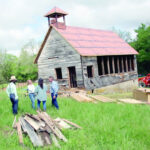Cassville Mercy Hospital performed approximately 1,300 mammograms in the past year.
The number was reached with the continued use of the new mammography unit, a Hologic Selenia Combo (dual) Imaging Unit, which was installed last year.
Gail Pierce, lead mammography tech with Cassville Mercy Hospital, has been doing mammograms here in Cassville for 35 years.
“Most everyone uses digital now; if not the 3D images, its digital,” she said. “It is nice because we can image the breast tissue in 2D and 3D during the same exam with no additional positioning or compression.
“It is, from the patient’s perspective, the same exam they have always had if they have had prior exams. The importance of 3D imaging is you have an increased degree of clarity and detail on a 3D image which is important, especially for dense breast tissue.”
Pierce said the nice thing about having 2D is that most women have had 2D studies, and hospitals always compare previous images to current images.
“We have always followed the American cancer Society and their recommendations,” Pierce said. “Their recommended age for a baseline exam is 35-40. An exemption to that would be someone who has symptoms or a family history. They also recommend that a self-breast exam should be done monthly.”
According to the American Cancer Society, the most common symptom of breast cancer is a new lump or mass (although most breast lumps are not cancer). A painless, hard mass that has irregular edges is more likely to be cancer, but breast cancers can be also soft, round, tender, or even painful.
Other possible symptoms of breast cancer include:
• Swelling of all or part of a breast (even if no lump is felt)
• Skin dimpling (sometimes looking like an orange peel)
• Breast or nipple pain
• Nipple retraction (turning inward)
• Nipple or breast skin that is red, dry, flaking, or thickened
• Nipple discharge (other than breast milk)
• Swollen lymph nodes under the arm or near the collar bone (Sometimes this can be a sign of breast cancer spread even before the original tumor in the breast is large enough to be felt.)
“People who are paying attention will notice a change quickly,” Pierce said. “Early detection is key for many treatments.”
At Cassville Mercy Hospital, mammograms are performed then the information is sent to their radiologists in Joplin.
“They read the images, do reports and recommendations,” Pierce said. “Sometimes the patient is referred to a surgical consult, the other option is for the patient to go back to their PCP and come up with a plan.”
Pierce said for a routine mammogram screening it process takes about 20 minutes.
“However, if you are coming in with a symptom we schedule an hour so you can speak with the doctor about results,” she said. “A typical mammogram screening is done on both breasts unless the patient has had a mastectomy.
“In my own experiences, sometimes I feel like there isn’t enough compression and other times it has been a bit painful. Every person has a different experience, and it varies from one appointment to the next.”
Pierce said there are a lot of factors that can influence how sensitive the breasts can be, including menstrual cycles.
“I recently read a study that said since COVID-19, they have seen a rise in the number of patients who are finding their breast cancer later,” she said. “Again, it is important to catch it early. Be diligent about your self exams and routine mammograms, that is going to help catch it as early as possible.”
People may visit www.nationalbreastcancer. org/breast-selfexam to learn more about how to perform a self-breast exam.




